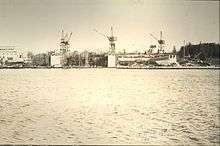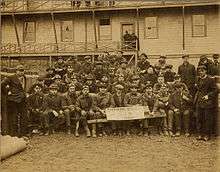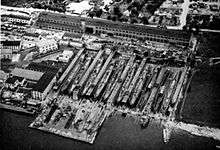Groton Iron Works
Groton Iron Works was a company formed in 1917 to build cargo ships for the United States Shipping Board during World War I. The company owned two shipyards: one in Noank, Connecticut for wooden ships; and the other in Groton, Connecticut for steel ships.[1] The focus of this article is the Groton, Connecticut yard.



Early property ownership
In 1916, Harry C. Rowe sold his 30-acre estate at Eastern Point to Charles W. Morse.[2] Charles W. Morse was president of United States Steamship Company,[3] which was the parent company of Groton Iron Works and Virginia Shipbuilding Corporation.[4] 4,993 shares of the 5,000 total shares of Groton Iron Works stock was owned by United States Steamship Company.[5] Qualifying shares were owned by the following: four shares by C.W. Morse and his three sons; one by Mr. Guggenheim; one by Mr. Loft; one unknown.[6] $3,500,000 was spent to construct Groton Iron Works, which employed 3,600 men.[7]
Groton Iron Works officers
E.A. Morse, President [8]
H.F. Morse, Vice President [9]
B.W. Morse, Secretary [10]
Steel cargo ship contracts
Emergency Fleet Corporation contract #57 S.C. for six 8,800 dead-weight ton steamers was signed 11 August 1917.[11]
Emergency Fleet Corporation contract #225 S.C. for six 9,400 dead-weight ton steamers was signed 20 April 1918. Three were eventually canceled due to the end of the war.[11]
Cargo ships built in Groton
| Contract # [11] | GIW Hull # [12] | EFC Hull # [12] | Name [12] | Keel Laid | Launched | Delivered |
|---|---|---|---|---|---|---|
| 57 | 1 | 372 | Tollard | 28 January 1918 [13] | 9 November 1918 [13] | 24 April 1919 [12] |
| 57 | 2 | 373 | Nameaug | 8 July 1919 [12] | 22 August 1919 [12] | |
| 57 | 3 | 374 | Worcester | 5 April 1919 [12] | 30 June 1919 [12] | |
| 57 | 4 | 375 | Quinnipiac | 1 November 1919 [12] | 12 December 1919 [12] | |
| 57 | 5 | 376 | Merry Mount | 20 September 1919 [12] | 18 October 1919 [12] | |
| 57 | 6 | 377 | Hartford | 29 November 1919 [12] | 31 December 1919 [12] | |
| 225 | 7 | 1542 | Honnedaga | 27 March 1920 [14] | July, 1920 [1] | |
| 225 | 8 | 1543 | Provincetown | 19 June 1920 [15] | September, 1920 [1] | |
| 225 | 9 | 1544 | Hopatcong | December, 1920 [1] |
Subsequent property uses

On 23 July 1922, the New York, New Haven and Hartford Railroad leased the property for use as a locomotive repair facility.[16]
On 30 January 1926, Hickman Sea Sled announced the lease of the jointer shop building.[17]
On 25 January 1927, Atlantic Coast Fisheries purchased the northern section of the property from Boston Iron and Metal Company,[18] to fillet, freeze and package haddock. In 1929 they purchased the remaining property, then sold some to Shell Oil Company for the construction of a distributing center with seven tanks.[19]
In January, 1941, a syndicate headed by Alfred Holter purchased most of the property, intending to build freighters for Britain.[20] Purchase price was $550,000 cash.[21]
On 5 February 1942, the US Navy purchased the property from Alfred Holter and Shell Oil Company for $222,000 using condemnation proceedings. $9.5 million was spent to construct the Victory Yard, where General Dynamics Electric Boat began building submarines on 22 July 1942.[23] On 3 November 1943 a Federal Court Committee awarded an additional $203,000 to the former owners.[24]
On 13 January 1945, General Dynamics Electric Boat announced that $3,000,000 will be spent to convert the Victory Yard to manufacture 105mm shells.[25]
On 18 December 1946, Pfizer Inc purchased the property from the War Assets Administration.[26] Purchase price was $911,999.[27]
References
- "Groton Iron Works, Groton and Noank CT". Shipbuilding History. Retrieved on 3 January 2011.
- Kimball, Carol W. "Anecdotes give insight into Atlantic Coast Fisheries". The Day. 17 January 2005. p. B6. Retrieved on 16 January 2011.
- "C. W. Morse Contracts". Hearings before Select Committee on U. S. Shipping Board Operations. Washington DC: Government Printing Office. 1920. p. 1088. Retrieved on 18 January 2011.
- "C. W. Morse Contracts". Hearings before Select Committee on U. S. Shipping Board Operations. Washington DC: Government Printing Office. 1920. p. 1237. Retrieved on 18 January 2011.
- "C. W. Morse Contracts". Hearings before Select Committee on U. S. Shipping Board Operations. Washington DC: Government Printing Office. 1920. p. CLXXIII. Retrieved on 18 January 2011.
- "C. W. Morse Contracts". Hearings before Select Committee on U. S. Shipping Board Operations. Washington DC: Government Printing Office. 1920. p. CLXXIIV. Retrieved on 18 January 2011.
- "C. W. Morse Contracts". Hearings before Select Committee on U. S. Shipping Board Operations. Washington DC: Government Printing Office. 1920. p. CXXXVI. Retrieved on 18 January 2011.
- "C. W. Morse Contracts". Hearings before Select Committee on U. S. Shipping Board Operations. Washington DC: Government Printing Office. 1920. p. 1122. Retrieved on 18 January 2011.
- "C. W. Morse Contracts". Hearings before Select Committee on U. S. Shipping Board Operations. Washington DC: Government Printing Office. 1920. p. 1131. Retrieved on 18 January 2011.
- "C. W. Morse Contracts". Hearings before Select Committee on U. S. Shipping Board Operations. Washington DC: Government Printing Office. 1920. p. 1061. Retrieved on 18 January 2011.
- "C. W. Morse Contracts". Hearings before Select Committee on U. S. Shipping Board Operations. Washington DC: Government Printing Office. 1920. p. 1215. Retrieved on 5 January 2011.
- "C. W. Morse Contracts". Hearings before Select Committee on U. S. Shipping Board Operations. Washington DC: Government Printing Office. 1920. p. CCXLIX. Retrieved on 3 January 2011.
- "Groton Iron Works Shipbuilding Plant". International Marine Engineering. April, 1919. pp. 246-250. Retrieved on 3 January 2011.
- "Launching party, freighter Honnedaga, Groton". Connecticut History Online. Retrieved on 4 January 2011.
- "Launching Party assembling, freighter Provincetown, Groton". Connecticut History Online. Retrieved on 4 January 2011.
- "Leases Groton Iron Works". The New York Times. 24 July 1922. Retrieved on 3 January 2011.
- "New London 25 and 50 Years Ago". The Day. 30 January 1951. p. 6. Retrieved on 11 January 2011.
- "Big Fisheries Concern Buys Iron Works Tract To Establish New Plant". The Day. 25 January 1927. p. 1. Retrieved on 13 January 2011.
- Kimball, Carol W. "Former Groton plant has cold, fishy history". The Day. 21 February 2005. p. B3. Retrieved on 10 January 2011.
- "GOVERNMENT: Money by Mail". Time. 20 January 1941. Retrieved on 6 January 2011.
- "Norwegian Fugitive From Nazis Here to Aid Britain". St. Petersburg Times. 11 January 1941. p. 24. Retrieved on 10 January 2011.
- "EB". The Day. 2 September 1995. p. A5. Retrieved on 13 January 2011.
- $203,000 More for Groton Works". The New York Times. 3 November 1943. Retrieved on 13 January 2011.
- "Electric Boat Co., Groton, Gets “Very Large Order” For Manufacture of 105 MM Shells". Lewiston Evening Journal. 13 January 1945. p. 7. Retrieved on 8 January 2011.
- "New London, Groton Salute Pfizer for Community Role; Plaque Given at Breakfast". The Day. 12 November 1954. p. 3. Retrieved on 10 January 2011.
- PFIZER BUYS WAR PLANT; Chemical Concern Gets WAA Shipyard at Groton for $911,999". The New York Times. 19 December 1946. Retrieved on 13 January 2011.